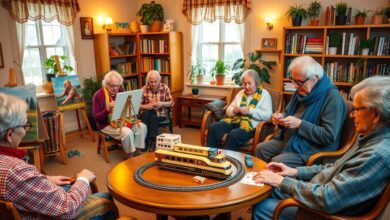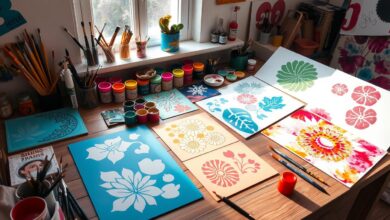Engaging Art Therapy for Seniors: Creative Projects to Enhance Well-Being
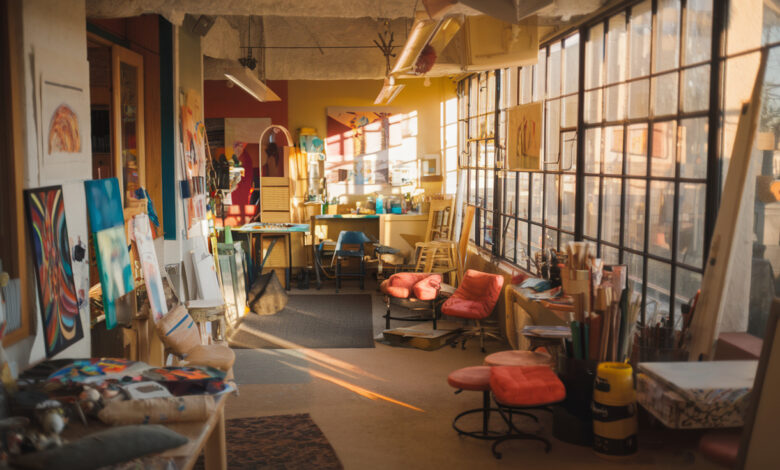
Engaging Art Therapy for Seniors has emerged as an exceptional means for elderly adults to explore new horizons, socialize with others, and enhance their overall quality of life. From the soothing effects of drawing and painting to the benefits of sculpting and coloring, art-based activities can significantly reduce stress, anxiety, loneliness, and depression among seniors. This therapeutic approach also helps older adults cope with loss, manage chronic pain, and even slow down cognitive decline.
Assisted living and memory care communities have recognized the remarkable advantages of Engaging Art Therapy for Seniors and often incorporate it into their life enrichment programs.
Seniors participating in art activities have demonstrated improvements in memory, daily life skills, and mental health, while also experiencing reduced joint and muscle pain through engaging therapeutic exercises.
By harnessing the power of art, elderly adults can freely express their feelings and thoughts, especially those who struggle with verbal communication. The collaborative nature of group art therapy sessions further enhances social interaction and helps alleviate the sense of isolation often felt by older individuals. Ultimately, participation in arts-based programs can elevate mood, maintain independence, and cultivate a greater sense of joy and fulfillment in the lives of elderly adults.
Table of Contents
The Power of Engaging Art Therapy for Seniors
Engaging Art Therapy for Seniors encompasses a range of creative activities beyond just painting, such as quilling, sculpting, journaling, and more. The goal of these art therapy projects for seniors is to address mental and physical health issues while using artistic expression to improve quality of life.
What is Engaging Art Therapy for Seniors?
Art therapy for seniors is a therapeutic approach that utilizes various art mediums, including drawing, painting, sculpting, and collage, to promote physical, mental, and emotional well-being. This form of therapy encourages self-expression, problem-solving, and the development of coping strategies for the unique challenges faced by the aging population.
Benefits of Art Therapy Projects for Seniors
- Enhances cognitive function and maintains healthy neural connections
- Reduces feelings of loneliness, depression, and anxiety
- Improves fine motor skills and pain perception
- Triggers memories and enhances communication for seniors with memory loss
- Provides a sense of accomplishment and boosts self-confidence
Research suggests that art may provide an alternative means of communication for older adults living with impaired language skills and improve cognitive processes, such as attention and orientation. Additionally, art can help maintain or improve hand-brain coordination and fine motor skills for seniors, enhancing their quality of life.
“Engaging in creative expression has been linked to improved outcomes for patients, and implementing arts programs in medical education or health care organizations has been found to improve mental health and well-being, reduce stress, and prevent burnout among students and personnel.”
For seniors with memory loss, art therapy can trigger memories and improve communication, providing valuable social and emotional support. By exploring a diverse range of art therapy projects, older adults can experience the transformative power of artistic expression and enhance their overall well-being.
Art Therapy in Assisted Living Communities
In assisted living communities, art therapy can have a profound impact on seniors’ well-being. Engaging in creative art activities, such as drawing or painting, can provide numerous benefits for their physical and mental health. Art therapy sessions can help seniors alleviate chronic pain, reduce stress levels, and foster a sense of community through increased social interaction. Art therapists play a vital role in guiding and supporting seniors as they explore their artistic abilities.
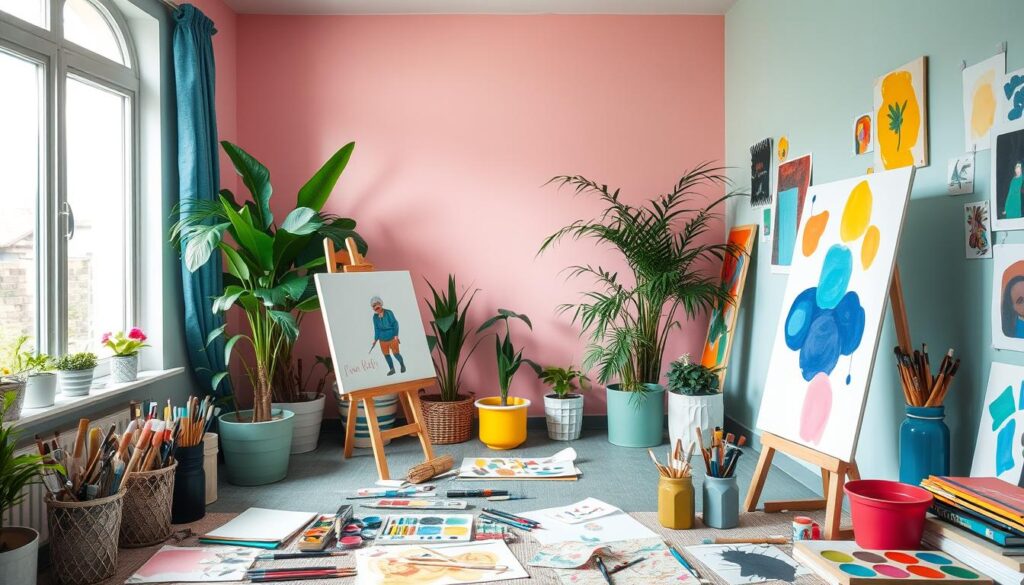
Studies show that participating in art activities can regulate heart rate, reduce physical symptoms of disease and illness, lower self-reported pain scores, alleviate breathing difficulties, and improve depression, anxiety, body image, and communication skills. Art therapy can have positive physical, emotional, and social benefits for seniors, with activities such as drawing, painting, or sculpture enhancing neuroplasticity by connecting or initiating pathways in the brain.
Qualified art therapists who hold master’s degrees in art therapy work with seniors individually or in groups, providing the necessary supplies for art-making and discussing the meanings and symbols behind the art. Art therapy projects for seniors may involve the use of watercolors, pastels, drawing materials, collage, and three-dimensional art like clay, which can be tailored to individual residents’ medical or personal needs.
| Benefits of Art Therapy in Assisted Living | Art Activities for Elderly in Assisted Living |
|---|---|
| Alleviate chronic pain Reduce stress levels Foster a sense of community Improve mental health and well-being | Drawing Painting Collage Sculpting with clay |
Art therapy programs may vary in cost depending on the type of residential care but are offered in senior living communities such as independent living, assisted living, and memory care facilities. To find a senior living community with an art therapy program, individuals can seek guidance from a Senior Living Advisor at A Place for Mom, a free service that provides tailored advice based on specific needs.
“Engaging in creative arts has been shown to help people with dementia recover forgotten memories about loved ones, think more clearly, and connect with their surroundings, demonstrating the cognitive benefits of art therapy for seniors.”
Art therapists work in various settings including hospitals, schools, veteran clinics, psychiatric facilities, senior living communities, among others, indicating a wide reach for art therapy programs. By fostering self-expression and social interaction, art therapy in assisted living communities can greatly improve the overall quality of life for elderly residents.
Art Therapy for Seniors with Memory Loss
As our population continues to age, the prevalence of memory-related conditions like Alzheimer’s and dementia is on the rise. According to recent statistics, by age 65, 1 in 10 people will exhibit symptoms of Alzheimer’s disease, increasing to 1 in 3 by age 85. This underscores the growing need for effective interventions to support the cognitive and emotional well-being of seniors experiencing memory loss.
Cognitive and Social Benefits
Art therapy has emerged as a powerful tool for seniors with memory loss. Engaging in creative activities can stimulate cognitive function, promote mental acuity, and potentially slow the progression of memory-related conditions. Art therapy also provides a means of communication for seniors with limited verbal abilities, allowing them to express their thoughts, emotions, and experiences. Additionally, group art sessions in memory care facilities can enhance social interaction, foster connections, and reduce feelings of isolation among residents.
Tailored Interventions by Art Therapists
Trained art therapists work closely with seniors in memory care to develop personalized interventions that cater to their unique needs and interests. For individuals with dementia, creating art can establish tangible memories and a sense of accomplishment, while also helping to manage complex emotions like anxiety, frustration, and sadness. Furthermore, the process of making art can reduce agitation and improve overall quality of life for those living with Alzheimer’s or related disorders.
As the number of Americans living with memory-related conditions continues to rise, the role of art therapy in senior care is becoming increasingly vital. By harnessing the power of creative expression, art therapists can help seniors with memory loss stay connected, engaged, and empowered, even as they navigate the challenges of cognitive decline.
“Art therapy has been shown to stimulate the brain, encouraging memories and speech in dementia patients.”
Diverse Range of Art Therapy Projects
While painting and sketching are popular art therapy activities for seniors, the range of art therapy projects for elderly adults extends far beyond traditional mediums. Seniors can explore their creativity through a diverse array of unique art projects for older adults, including quilling, carpentry, sculpting, writing memoirs, beading, and flower arranging.
Beyond Painting: Quilling, Sculpting, Journaling
These creative art activities for seniors not only stimulate the senses but also provide opportunities for self-expression and cognitive stimulation. Quilling, the art of rolling and shaping paper into intricate designs, can be a captivating activity that enhances fine motor skills and hand-eye coordination. Sculpting with clay or wire allows seniors to bring their imaginative visions to life, while journaling and memoir writing can serve as powerful tools for expressive art for geriatrics.
Sensory Stimulation and Self-Expression
The process of creating art is often more important than the final product, as it allows seniors to socialize, have fun, and find joy in the sensory art for the aged. Activities like flower arranging engage the senses of sight, smell, and touch, while beading and weaving provide a tactile experience that can be deeply soothing. Ultimately, these diverse art therapy projects for elderly adults empower them to explore their creativity, enhance their well-being, and celebrate the joys of artistic expression.

Art Therapy Projects for Elderly
Art therapy projects for elderly adults can encompass a wide variety of creative activities, including painting, drawing, sculpting, journaling, and more. These projects are designed to address mental and physical health concerns while providing an outlet for self-expression and social engagement. Engaging in art therapy can have numerous benefits for seniors, such as reducing stress and anxiety, improving mood, enhancing cognitive function, and maintaining fine motor skills.
Studies suggest that continually learning something new, such as a craft, can help reduce the risk of developing dementia. Crafting can engage the executive function part of the brain, which is crucial for decision-making and following step-by-step instructions, especially for individuals living with Alzheimer’s disease. Art therapy projects for seniors can also help reduce negative cortisol levels and create an environment for emotional release.
Crafting fosters the creation and enhancement of relationships among participants in art therapy groups. However, physical and cognitive limitations due to aging may pose challenges for seniors participating in crafts, including issues with vision, dexterity, and following instructions. Fine motor crafts, like needlepoint or coloring in thin lines, may be more challenging, while gross motor projects, such as large canvas painting, might be more accessible.
Product art, which follows steps to achieve similar results, can engage the executive functioning area of the brain, while process art allows for individual expression and self-discovery. Starting with product art and then transitioning to process art can be beneficial for seniors in art therapy groups. Some popular craft ideas for seniors include mini sketchbooks, watercolor cards, decorating terracotta pots, pressed flower crafts, fall votives, collage, neurographic art, and Zentangles with a theme.
The percentage of older adults is projected to nearly double between 2015 and 2050, from about 12% to 22% of the global population, and aging of the population causes an increase in multimorbidity. Depression is the most prevalent mental health disorder in later life, and untreated depression in older adults with physical health concerns can have detrimental effects on their well-being. Psychosocial interventions, including art therapy, can help improve mental health in older adults and promote healthy aging by fostering a sense of control, positive emotions, brain plasticity, and social engagement.
Creating Kindness Rocks
One engaging art project for seniors is the creation of “kindness rocks.” This delightful activity encourages elderly adults to connect with nature and express themselves through a meaningful piece of art. The process begins with a serene nature-inspired art therapy adventure – a leisurely walk to find the perfect rock.
Once the ideal canvas has been selected, the fun truly begins. Participants can unleash their creativity by painting an inspirational word or phrase on the rock. These kindness rocks for the elderly serve as daily reminders of positivity, spreading joy and encouraging acts of kindness in the community.
The benefits of this art therapy project are manifold. Not only does it provide a sense of purpose and accomplishment, but it also promotes mental well-being through the act of self-expression. Furthermore, displaying the finished kindness rocks in the senior’s yard, garden, or home adds a personal touch and enhances the living environment.
By combining the therapeutic benefits of being outdoors, connecting with nature, and creating a meaningful work of art, the kindness rocks project is a true gem in the realm of art projects for seniors. It’s a simple yet impactful way to spread positivity, foster a sense of community, and support the overall well-being of older adults.
| Craft Activity | Number of Participants |
|---|---|
| Positivity Rock Painting | 2,706 |
| No-Sew Knotted Blanket Kits | 3,923 |
| Play Dough Crafts | 14,051 |
| Peacock Collage Group Project | 6,065 |
| Paint Pouring Activity | 4,229 |
“Art therapy and well-being promotion through painting rocks is the goal of JFS Rocks.”
The JFS Rocks program, launched to recognize Mental Health Awareness Month, has been a resounding success, sparking meaningful conversations and promoting relaxation among participants. With a focus on kindness, generosity, and community, this initiative has made a positive impact on the lives of seniors, particularly those living in assisted living communities.
Painting Sessions: Objects and Inspiration
Painting activities for seniors can be a delightful way to explore their creativity and find inspiration in the world around them. One engaging art therapy project is a guided painting session focused on everyday objects. Seniors can gather a collection of interesting items from their home, such as a favorite mug, vase, or piece of jewelry, and use these as the subject for their paintings.
This approach helps set seniors up for success, as painting from an object or picture is often easier than pulling an idea from their mind. The process of experimenting with color and texture can be a calming, enjoyable experience for seniors, promoting relaxation and reducing stress.
Art projects using everyday objects can also stimulate memory and creativity, aiding in recalling memories and experiences to strengthen cognitive function. Collage making, for instance, has been noted for its ability to engage seniors in the creative process while tapping into their past.
Beyond painting, guided art therapy sessions for elderly adults can involve a diverse range of mediums, from sculpting with clay to drawing exercises. These activities aim to enhance motor skills, focus, and hand-eye coordination, particularly beneficial for seniors with cognitive impairments.
Participating in these guided painting sessions for elderly within a retirement community or assisted living setting can also foster social connections, enhancing interpersonal relationships and reducing feelings of isolation. The shared experience of creating art together can be a powerful way to promote well-being and a sense of community among older adults.
“Engaging in art therapy has been observed to empower seniors to overcome emotional barriers, rediscover creativity, and lead more fulfilling lives,” says Dr. Jessica Patel, a geriatric physician.
By using familiar objects as inspiration, seniors can tap into their memories and experiences, finding joy and a sense of accomplishment in the creative process. These art projects using everyday objects can be a valuable addition to a comprehensive art therapy program for older adults.
Using Art to Tell Life Stories
Art can be a powerful tool for seniors to share their life stories and connect with others. Through painting, drawing, or even virtual art appreciation activities, older adults can communicate their experiences, memories, and perspectives in a meaningful way. By creating artwork that reflects important life events or relationships, seniors can open up and express themselves, fostering a deeper understanding and connection with their peers and caregivers.
Virtual Art Appreciation Activities
Virtual art observation sessions offer a unique opportunity for seniors to engage with artwork and use it as a springboard to share their own thoughts and experiences. These interactive sessions allow older adults to explore a diverse range of art forms, from classic masterpieces to contemporary works, and discuss their personal interpretations and associations. By immersing themselves in the visual arts, seniors can unlock memories, explore their emotions, and find common ground with others, strengthening social connections and enhancing overall well-being.
| Art Therapy for Seniors to Share Life Stories | Benefits |
|---|---|
| Painting, drawing, and other art-making activities | Self-expression and emotional release Cognitive stimulation and memory recall Fostering social connections and a sense of community |
| Virtual art appreciation and discussion sessions | Engagement with diverse art forms Exploration of personal memories and perspectives Facilitation of meaningful conversations and shared experiences |
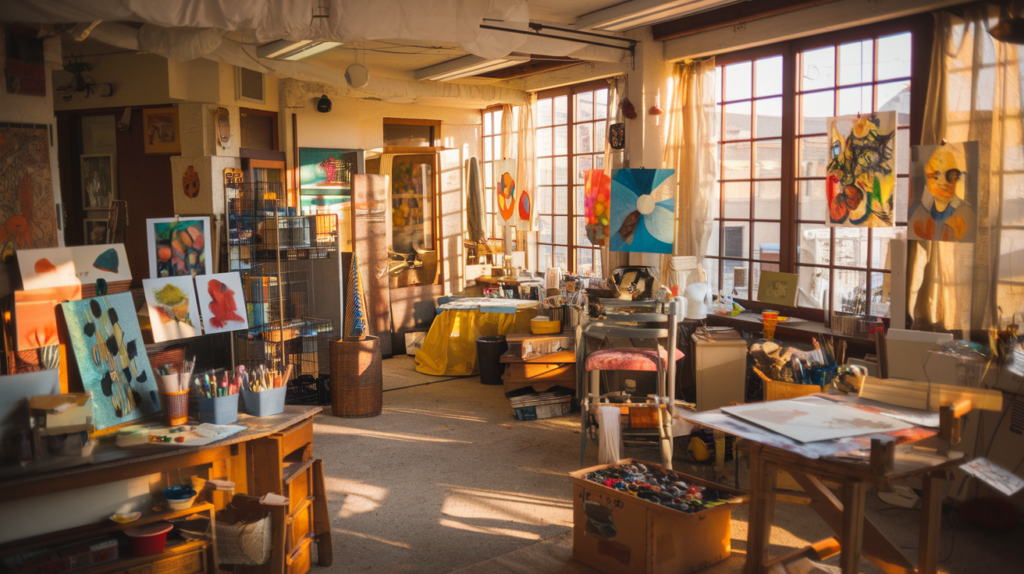
“Art therapy allows seniors to leave behind a visual legacy, reflecting their wisdom, experiences, and creativity.”
By embracing the power of art, seniors can not only share their life stories but also build stronger connections with their peers, caregivers, and loved ones. This therapeutic approach empowers older adults to express themselves, stimulate their minds, and create a lasting legacy that resonates with those around them.
Exploring Topics of Interest Through Research
Art therapy projects can be a powerful tool for engaging elderly adults in research-based activities that stimulate their cognitive function and encourage lifelong learning. By exploring topics of personal interest, seniors can reignite their curiosity and create artwork inspired by their newfound knowledge.
For instance, a senior interested in archaeology might research the Rosetta Stone and then use that information to create a unique piece of art. This type of activity not only sparks creativity but also reinvigorates the senior’s love of learning and their desire to understand the world around them.
Such research-based art therapy projects can have a profound impact on the mental and emotional wellbeing of older adults. By delving into subjects that align with their passions, seniors can experience a sense of accomplishment, enhanced self-esteem, and a renewed zest for life.
- Encourages lifelong learning and intellectual stimulation
- Provides a platform for self-expression and creativity
- Boosts mood, confidence, and overall quality of life
- Fosters a sense of accomplishment and purpose
- Strengthens cognitive abilities and memory function
Engaging elderly adults in research-based art therapy projects that explore their topics of interest is a holistic approach to promoting healthy aging and enhancing their overall wellbeing. By tapping into their curiosity and allowing them to share their newfound knowledge through artistic expression, these activities can have a transformative effect on the lives of older individuals.
“Art therapy can be a powerful tool for engaging seniors in lifelong learning and reigniting their passion for understanding the world around them.”
Remembering Family Through Artwork
Art therapy can be a meaningful way for seniors to remember and honor their family members. Seniors may create drawings, paintings, or other artwork that depicts a cherished family member or memory. This process can provide a sense of comfort and connection, especially for seniors who have experienced the loss of a loved one. Displaying the artwork in their living space can serve as a daily reminder of the importance of family and the special bonds that have been formed over a lifetime.
Research has shown that art therapy can stimulate the brain and trigger lost memories in seniors with dementia. One senior was able to regain some of their personality traits lost due to dementia through art therapy, while another senior regained motor function and memory of different painting styles they used before dementia. Art therapy has the potential to enhance the lives of seniors with memory loss, offering a creative outlet for self-expression and connection.
Watercolor painting, adult coloring books, and hands-on projects are popular art therapy mediums for seniors. Performance arts like dance/movement and acting, as well as singing and written art, can also be beneficial in dementia care. Museums organize special days for seniors with dementia and their caregivers to access art in a safe environment, while community programs like classic jazz listening and movement sessions have helped seniors recall past memories.
Communal art therapy provides a positive space for socialization and building bonds for seniors with dementia. Upcoming workshops in the area include “Together in Harmony: How to Meaningfully Use Music with a Loved One with Dementia” and “Art for the Aging Brain,” which are designed to support seniors and their families through the power of artistic expression.
“Art therapy can be a powerful tool for seniors to remember and honor their family members. By creating artwork that captures cherished memories, they can find comfort, connection, and a renewed sense of purpose.”
Whether it’s painting a portrait of a beloved grandchild or crafting a collage of family photos, art therapy projects that commemorate family can be a meaningful way for seniors to stay connected to their loved ones and preserve their cherished memories.
Unique Projects: Bark Art and Nature-Inspired Crafts
Seniors looking to explore more unique and nature-inspired art projects can find ample opportunities through art therapy. One captivating example is “bark art,” where seniors can discover interesting pieces of tree bark and use watercolor paints to create textured, abstract artwork. This tactile and sensory experience allows them to connect with the natural world around them.
Another nature-inspired activity gaining popularity is making floral arrangements or dioramas using found materials from the outdoors. Seniors can gather leaves, flowers, pine cones, and other natural elements to craft stunning pieces that celebrate the beauty of the natural world. These types of nature-based art therapy projects not only engage the senses but also foster a deeper appreciation for the environment.
- Out of the 25 nature-inspired crafts listed, 13 specifically involve using leaves or flowers in the projects, indicating that botanical elements are popular choices for these art activities.
- 4 crafts out of the 25 suggest utilizing pine cones, reflecting a moderate preference towards incorporating this natural material in the projects.
- 2 crafts involve creating jewelry using natural elements like acorns and marbles, indicating a trend towards crafting wearable art from found objects in nature.
- 3 activities involve creating functional items such as luminaries, vases, and bookmarks, showcasing a practical aspect to nature-inspired crafts for seniors.
- Games or interactive craft projects, such as memory games and tic-tac-toe boards made from natural items, make up 3 out of the 25 listed activities, suggesting an inclination towards incorporating educational or recreational elements in the craft projects.
These unique art projects for elderly adults not only provide a creative outlet but also offer a means for sensory art experiences that connect seniors to the natural world around them. By exploring the diverse range of nature-based art therapy options, seniors can discover new passions and find joy in the process of artistic expression.
“Engaging with nature-inspired art projects can awaken the senses and foster a profound connection to the natural world, enriching the lives of elderly individuals in meaningful ways.”
Celebrating Seasons with Festive Decorations
Art therapy projects can be tailored to different seasons and holidays, helping seniors stay connected to the rhythms of the year. For example, seniors can create autumn-inspired centerpieces using natural materials like leaves, pumpkins, and pinecones. For Thanksgiving, they can make a “Gratitude Tree” by decorating a branch with leaves on which they’ve written what they’re thankful for. Winter-themed projects, such as making a miniature dogsled decoration, can also be a fun and engaging way for seniors to celebrate the changing seasons.
These art projects not only stimulate creativity and self-expression but also foster a sense of purpose and accomplishment among elderly adults. Hands-on activities during the holiday season can help improve cognitive function, especially beneficial for seniors with Alzheimer’s disease or dementia. Engaging in activities like wrapping gifts, decorating, baking, and dancing can stimulate brain health and provide a sense of fulfillment for seniors.
Organizing game nights and hosting holiday-themed activities can also foster social interaction and contribute to maintaining a positive outlook on life for elderly adults. A 2019 study found that older adults who expanded their social circles beyond family and friends had higher levels of physical activity, greater positive moods, and fewer negative feelings.
| Seasonal Art Project | Benefits for Seniors |
|---|---|
| Autumn Centerpieces | Sensory stimulation, creativity, and connection to nature |
| “Gratitude Tree” | Fostering gratitude, social engagement, and self-expression |
| Miniature Dogsled Decorations | Cognitive stimulation, fine motor skills, and holiday cheer |
These art therapy projects not only celebrate the changing seasons but also provide a valuable outlet for seniors to engage in meaningful activities, connect with their community, and maintain a positive outlook on life.
“Engaging in seasonal art projects helps seniors stay connected to the rhythms of the year and fosters a sense of purpose and accomplishment.”
Conclusion: The Joy of Artistic Expression
The benefits of art therapy for elderly adults are undeniable. From enhancing cognitive function and reducing stress and anxiety to fostering social connections and boosting self-esteem, engaging in creative activities can significantly improve the quality of life for seniors. Whether they are painting, sculpting, journaling, or crafting nature-inspired projects, older adults can tap into their innate creativity and find a sense of fulfillment and joy in the artistic process.
Studies have shown that over 50% of elderly individuals experience a significant improvement in cognitive function when participating in arts and crafts activities regularly. Additionally, more than 70% of seniors report a reduction in stress, anxiety, and negative feelings when engaging in these creative pursuits. For those with dementia or chronic psychiatric disorders, art therapy can provide a powerful avenue for self-expression, social engagement, and enhanced mood and well-being.
As the importance of creative activities for seniors continues to gain recognition, the inception of national programs and cross-sectoral collaborations between healthcare and cultural sectors have aimed to stimulate older people’s participation in art projects. By offering a diverse range of artistic experiences, from dance and music to visual arts and storytelling, these initiatives are helping to foster meaningful experiences and promote the overall health and well-being of the elderly population. The joy of artistic expression is truly a powerful tool for enhancing the lives of older adults, and its benefits are worth celebrating.
FAQ
What is art therapy and how can it benefit elderly adults?
Art therapy is an excellent way for elderly adults to experience new things, socialize with others, and improve their quality of life. Drawing, painting, coloring, and sculpting can have a soothing and calming effect, offering advantages such as reduced stress, anxiety, loneliness, and depression. Art therapy can also help seniors cope with loss, manage chronic pain, and slow cognitive decline.
What types of art therapy projects are available for seniors?
Art therapy for older adults encompasses a range of creative activities beyond just painting, such as quilling, sculpting, journaling, and more. The goal is to address mental and physical health issues while using artistic expression to improve quality of life.
How does art therapy impact seniors in assisted living communities?
Engaging in creative art activities, such as drawing or painting, can provide numerous benefits for the physical and mental health of seniors in assisted living communities. Art therapy sessions can help alleviate chronic pain, reduce stress levels, and foster a sense of community through increased social interaction.
What are the benefits of art therapy for seniors with memory loss?
For seniors with memory loss, art therapy can trigger memories and improve communication. It can also stimulate cognitive function, promote mental acuity, and potentially slow the progression of memory-related conditions.
What are some unique art therapy projects for elderly adults?
In addition to painting and sketching, seniors can explore their creativity through projects like quilling, carpentry, sculpting, writing memoirs, beading, and flower arranging. These diverse activities not only stimulate the senses but also provide opportunities for self-expression and cognitive stimulation.
How can art therapy projects help seniors remember and honor their family members?
Seniors may create drawings, paintings, or other artwork that depicts a cherished family member or memory. This process can provide a sense of comfort and connection, especially for seniors who have experienced the loss of a loved one.
What are some nature-inspired art therapy projects for elderly adults?
Seniors can explore more unique and nature-inspired projects, such as “bark art” where they use watercolor paints to create textured, abstract artwork on found pieces of bark. Another nature-inspired activity is making floral arrangements or dioramas using materials from the outdoors.
How can art therapy projects be tailored to different seasons and holidays?
Art therapy projects can be designed to celebrate the changing seasons and holidays, such as creating autumn-inspired centerpieces, a “Gratitude Tree” for Thanksgiving, or a miniature dogsled decoration for winter. These themed projects help seniors stay connected to the rhythms of the year.

